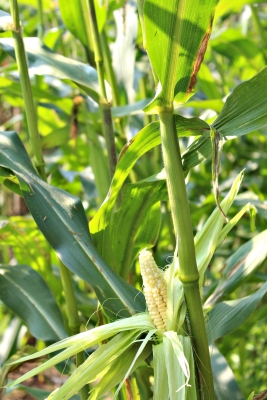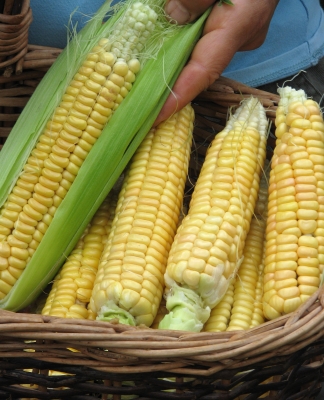SWEET CORN OP-ED
Ah, the Good Ole’ Days
The good ol’ days seemed to have had snowier winters, greener grass, and more toothsome apples. Perhaps it was so. One thing those good ol’ days definitely did not have was sweeter sweet corn. Only in the past few decades have plant breeders found new genes that shoot the sugar content of sweet corn sky-high.

Papoon corn, the first recorded variety of sweet corn, probably originated as a chance mutation of a single gene of field corn. That gene, the so-called sugary gene (abbreviated su), brought the sugar level in corn from four percent up to ten percent.
We gardeners have tried to make the most of that ten percent ever since the time when 18th century Plymouth, Massachusetts gardeners first grew Papoon corn. We pick an ear just when each kernel is creamy and as sweet as can be. Since sugars in corn start changing to starch as soon as the ear is picked, we eat the corn right out in the garden or else rush it to the kitchen to a pot of already boiling water. In only one day, half that sugar will turn to starch.
Quantum Corn
Sweetness in sweet corn took a quantum leap around the middle of the last century as a result of two genes. The first gene, called the shrunken-2 gene (abbreviated sh2) because of the way the dried kernels shrivel up, pushes the sugar level in corn up to a whopping thirty-seven percent. Not only that, but even two days after picking, that corn still has twenty-nine percent sugar.
The variety Illini Xtra Sweet was the first of the appropriately-named “supersweet” sweet corns. Other varieties with this gene are Early Xtra Sweet, American Dream, and SignatureXR. Kernels of these varieties have thick skins and lack a creamy texture.
The second gene responsible for sweeter sweet corn is the “sugar enhanced gene” (abbreviated se). The se gene is effective only in combination with the su gene of regular sweet corn, and the combination of the two genes results in varying degrees of sweetness, typically about twice as sweet as traditional sweet corn, and tender kernels.
Still no need to scurry to the kitchen with se varieties, because they also retain their sweetness for a long time, but only because they start out sweeter. Kandy Korn EH, Sugar Buns EH, Silverado, and Snow Queen EH are varieties with the se gene. Many of these varieties have “EH,” which stands for “everlasting heritage,” in their names.
Juggling genes around to get the best of all worlds resulted in two more hybrid types of corn. “Synergistic” (syn) varieties have some su kernels from traditional sweet corn added to each ear of supersweet (shr) corn, typically about 25%, in an effort to balance sweetness, creaminess of texture, and tenderness. “Augmented sh2” varieties have some se and su genes added to an sh2 parent, basically combining all of the above genes, resulting in more sweetness and less toughness.
In case you’re wondering, none of these varieties are necessarily genetically modified (GM). All can be produced with traditional corn breeding techniques.
What’s Not to Love
Why doesn’t every gardener plant these new sweet corns? (Because of their sweetness and their ability to hang on to it longer after harvest, pretty much every farmer does limit their planting to these newfangled corns these days.) One reason not to plant these varieties is because these varieties need special care. Their seeds are finicky, and will rot just as soon as grow if planted in soils that are too cool, too dry, or too wet. Soil microorganisms also like that extra sweetness. Even after the seeds have been coaxed to germinate, the resulting seedlings often lack vigor.
The sweeter sweet corns can lose almost all their sweetness if the wrong pollen blows onto their silks. Basically, all of the above varieties need to be isolated from all of the other above varieties except for the combination of traditional (su) varieties and sugar enhanced (se) varieties, although cross-pollination between the latter two will dilute full expression of each variety’s characteristics. The only way to minimize contamination between varieties is to separate them by at least 250 feet, or else plant varieties whose maturities differ by more than two weeks.
And what about flavor: Is sweetness all we want from sweet corn? The sweeter sweet corn varieties tend to taste watery and lack a “corny” flavor. If breeders could develop a sweet corn with ninety-five percent sugar, would that be even better?
Corn with thirty-seven percent sugar tastes too sweet to many gardeners. I remember years ago stopping at the farmstand of one of the large local growers and asking them if they had any Golden Bantam, an old fashioned variety of sweet — not supersweet — corn for sale. The farmer’s wife grinned sheepishly and said they grow that variety for themselves.

Golden Bantam-m-m-m-m
A milk chocolate bar, with about fifty percent sugar, isn’t all that much sweeter than a supersweet variety of corn, some of which can have as much as 44% sugar.
For some of us, traditional sweet corn varieties — such as, in addition to Golden Bantam, once-popular varieties as Seneca Chief, Stowell’s Evergreen, Country Gentleman, and Silver Queen — are as delicious as corn needs to be if they are picked at just the right stage, then eaten within minutes. Ten percent sugar, especially when coupled with with a rich, corny flavor, and some degree of chewiness, is enough for me.
In the past, I’ve heaped praise on Golden Bantam corn, which was the standard for excellence in sweet corn a hundred or so years ago. I grow only this variety, more specifically “8-row Golden Bantam,” which distinguishes it from many Golden Bantam sired hybrids, such as Golden Cross Bantam and Top Cross Bantam.

Golden Cross Bantam (not bantam)
Last year I feared I hit a bump in the road with Golden Bantam, as one-quarter of my planting yielded nothing worth harvesting due to what may have been northern corn leaf blight. I went ahead and planted 8-row Golden Bantam again this spring and am happy to say that the corn looks fine.
Four 20 by 3 foot beds, with double rows of “hills” 2 feet apart in each row and 3 plants per hill, provides all our household needs for fresh steamed or roasted ears and frozen kernels for winter.

Bed of sweet corn

